Printable Version of Topic
Click here to view this topic in its original format
914World.com _ 914World Garage _ How much stiffer with solid or tied in roof?
Posted by: Mueller Dec 12 2004, 11:17 AM
New car has no cage, I know the 914 tends to flex and that the factory welded steel roofs on the 916 for what I guess was to help stiffen them, or was it for other reasons??
The 'glass top should help a little, but I was wondering about attaching tubes or the like from the factory roll bar to the windshield hoop to stiffen the car up....
Has anyone played with this before??
Posted by: Bleyseng Dec 12 2004, 11:34 AM
An X brace would help alot to stiffen things up, but how stiff is the windshield frame anyway?
Geoff
Posted by: neo914-6 Dec 12 2004, 11:45 AM
Mike,
Don't have historical data on the 916 but I plan to use engman's lower bracing if I don't use a cage. Here's a hack solution! ![]()
Felix
Attached image(s)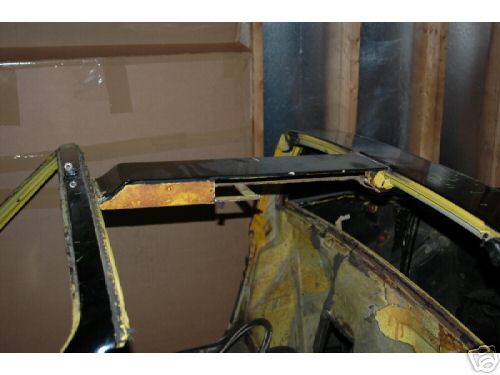
Posted by: GWN7 Dec 12 2004, 11:45 AM
I saw this on one car. Don't know how functional it would be.
LOL same pic ![]()
Attached image(s)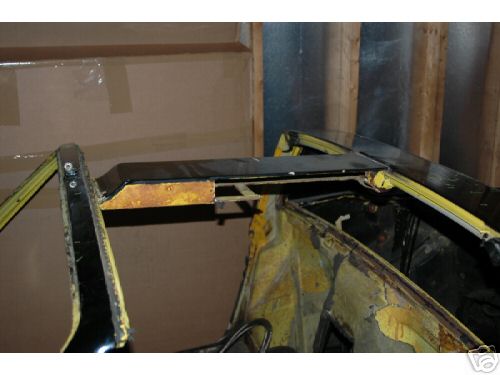
Posted by: neo914-6 Dec 12 2004, 11:47 AM
![]()
![]()
![]()
And this is on an original 914-6 currently at ~600 on eBay!
Felix
Posted by: airsix Dec 12 2004, 01:07 PM
Mike,
It's so funny to ready your threads like this becuase you usually post about something that I'm actually scratching my own chin about. I've thought about doing a cross-brace like this myself. I was thinking about maybe doing a box-steel 'X' of light-guage steel and glassing it into the undersid of the roof. Then tie it in to the targa bar and windshield frame w/ removable plates.
Now that I've got a new daily driver I'm just going to do a cage though.
-Ben
Posted by: ein 6er Dec 12 2004, 01:24 PM
this is the brumos gt
Posted by: ein 6er Dec 12 2004, 01:24 PM
front
Posted by: ein 6er Dec 12 2004, 01:25 PM
back
Posted by: michel richard Dec 12 2004, 01:42 PM
I thought I read somewhere that the 914, new and un-rusty, was designed to be just as stiff as a 911 coupe. Has anyboldy else heard of this ?
Michel Richard
Posted by: campbellcj Dec 12 2004, 01:48 PM
I know even with an 8-point welded cage, the tub still has "some" flex, because I have a skin targa top attached with dzus fasteners and it squeeks and rattles quite bit. That tells me there's a little motion going on. I figure it's the A-pillar (windshield frame) since the cage is tied into the targa bar. The A-pillar on any roofless car or even a sunroof car is inherently gonna flex.
Posted by: Bleyseng Dec 12 2004, 01:49 PM
Maybe 911 Targa.......
Posted by: sixnotfour Dec 12 2004, 02:22 PM
On the 914-6Gt pages the Gt in the Collier collection shows a picture of a reinforcing plate added at the base of the windshield frame. along with the bolted X-braced Gt top.
The factory must thought it would help ?
new car and the wheels are turnin already ![]()
Posted by: Jeroen Dec 12 2004, 02:24 PM
Like Geoff already mentioned, the windshield frame is pretty weak
The first factory race cars cracked their windshields because of the reinforced roofs
Later they also reinforced the pilars of the windshield frame
So... get Engman's kit and be done with it...
Posted by: airsix Dec 13 2004, 01:42 PM
Cool. That's almost exactly what I was talking about. I expected the cross-brace to be lighter and the tie-ins to be beefier, but that's the general idea I was talking about.
-Ben M.
Posted by: Eric_Shea Dec 13 2004, 07:36 PM
I've "heard" they're much stiffer.
Troy put the A-Pillar mod on Gint's car. Came out awesome. These things crack a-pillars, especially when autocrossed or raced.
When I restored my 911 the a-pillars were cracked. The factory did the reinforcement to prevent cracking. A-pillars are weak, weak, weak.
Here's a couple of pictures that Andy came over and took... ![]() (actually, the camera was pointed directly at the light so it didn't like to focus properly.)
(actually, the camera was pointed directly at the light so it didn't like to focus properly.)
Attached image(s)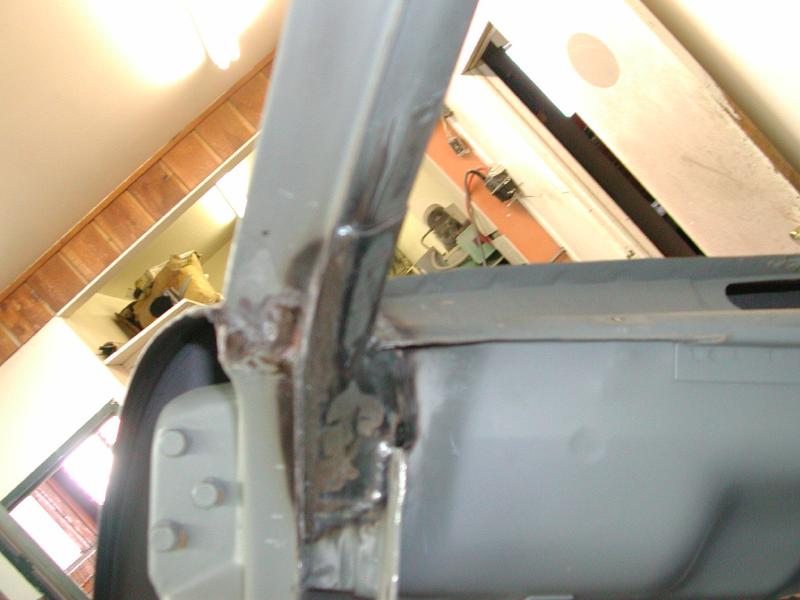
Posted by: Eric_Shea Dec 13 2004, 07:37 PM
nudder
Attached image(s)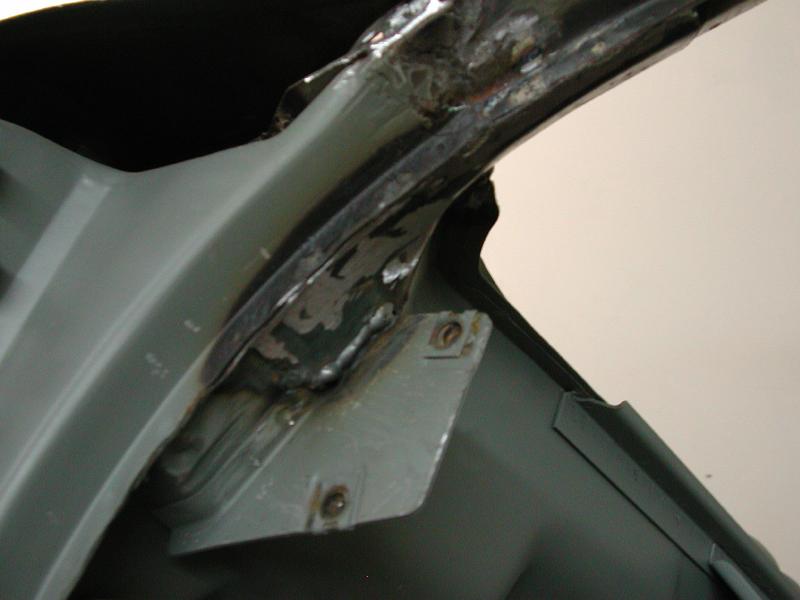
Posted by: Flat VW Dec 13 2004, 08:52 PM
Never push the car from the a pillars, I have my two boys, my wife and most of my friends "trained" by now! ![]()
Posted by: Slowpoke Dec 13 2004, 09:19 PM
I usually drill some holes in A-pillars and shoot in some expanding hard foam insulation. Not the home depot crap. But, the commerical stuff. Underneath the weather strip area and behind the A-post trim gets it in all the voids. It seems to add some strenght to the A-pillars and cowl area. Some cheaters back in the old days use to shoot foam into the sills, A-post and frame rails on some cars to strenghten the car a little. Not me, but other cheaters. ![]() Undercoating usually did a good job at hiding it under the car. At least that's what I heard.
Undercoating usually did a good job at hiding it under the car. At least that's what I heard. ![]()
Posted by: Brett W Dec 13 2004, 09:58 PM
If you add steel into the top you are hanging some major wieght up high in the chassis. It will have an affect on how the car feels. I think you would be better off laminating the stock top with some sort or honeycomb material and fiberglass. Anything you could do to make it stiffer with out using the steel the better.
The two part expanding foam works well. I know Ford is using it in some of its new vehicles. Make sure the chassis has no rust in the frame rails. Then fill with a commercial two part expanding foam. This will do wonders for the frequency of the chassis.
Engmans kit is a great addition for the average joe. Most cages that are put in cars only add weight and safety. Hopefully when I get some time after the first of the year I am going to be doing some torsional testing on my chassis. I just have to finish the chassis jig first.
Posted by: JOHNMAN Dec 13 2004, 11:43 PM
You guys surely jest....
The A-pillar weak. Please.
Have you ever cut a windshield off? There is a bunch of steel in there. Several thicknesses of sheet metal. Potentially, in a hard collision, the windshield frame may try to crack at the point where the rigid frame meets the rest of the unit body.
Those "stiffening plates" In my opinion were put there to reinstall a previously cut-off windshield frame.
Our cage has been tied into our windshield frame for over 16 years of track time and our windshield frame has not cracked off.
Now, I admit that there are some high stress concentrations in the windshield frame/cowl/fender area. We noticed that the fender/cowl interface is under considerable stress when we welded the cowl/fender joint and it kept cracking/moving.
We ended up cutting that area apart and replacing the steel in the area, but the area continues to do strange things especially at the sharp corner at the rear edge of the front trunk lid.
Posted by: Brett W Dec 14 2004, 12:17 AM
Yes I have cut the windshield off. The windshield and cowl wiegh in at less than 10lbs. There really isn't a lot of material in that area. There are several pieces of material that come together around the door jambs.
Notice the redline is a broken spot weld. You can see through to the fuel tank area. That panel is 1 peice of .050 sheetmetal. No top just an open unreinforced box. There is very little structural intergrity to this area. That is why these chassis twist so bad. The lower A pillar is really strong, not necessarily stiff. It does form a boxed section but the box is vertical and not really tied into the rest of the chassis. The reason it is so strong is because the doors have to hang off them.
The Blue line shows the multiple peices of metal that come togther in the area of the A-pillar, but they just connect like post. Vertical with the rest of the chassis hanging off the post. Very little reinforcement on three sides.
Attached image(s)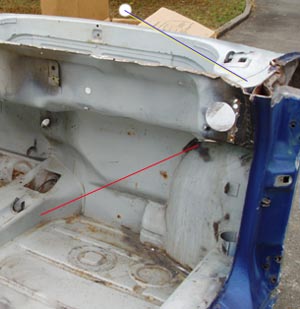
Posted by: JOHNMAN Dec 14 2004, 12:49 AM
Agreed.
So how does the previously referred to "reinforcement plate" welded into the lower A-pillar address any of this or help with the area where you show a broken spotweld?
Posted by: Brett W Dec 14 2004, 01:18 AM
It doesn't. What that patch does is, connect the windshield frame to the chassis a little better. It helps keep the windshield frame and the cowl/firewall flexing at the same rate/amount.
Posted by: Mueller Dec 14 2004, 10:57 AM
looking at the pictures of the cracked windshield frames, it seems like a more solid roof might increase the cracking at that point......
I think for a street car with no cage, if there was a way that one could make their doors more of a "stressed" member, that would really help stiffen the car. From what I understand the door jams and the hinges are pretty weak as is, so things would have to be reinforced.
It would be interesting to measure how much the door gaps increase/decrease while driving.
Posted by: Eric_Shea Dec 14 2004, 11:20 AM
The A-pillar weak. Please.
Have you ever cut a windshield off? There is a bunch of steel in there. Several thicknesses of sheet metal. Potentially, in a hard collision, the windshield frame may try to crack at the point where the rigid frame meets the rest of the unit body.
Those "stiffening plates" In my opinion were put there to reinstall a previously cut-off windshield frame.
Nope. And don't call us "Surely"
All I can tell you is "every single" restoration project I've tackled (2 911's and 2 914's) has had cracked a-pillars. We're currently looking at a 914-6 on a rotisserie (sic) that the windshield posts move more than 1/4".
Factory GT's have the stiffening plates welded in and these are cars that have a clear history of "never" having the windshield cut off. I'll cite the aerospace engineer that was looking at the car when we were contemplating the factory stiffening kit... "It's funny how many good-ole boys think they're smarter than the factory engineers".
So, I'll go by experience with all my 911's and 914's. A-Pillars crack. A picture is worth...?
Attached File(s)
Posted by: Eric_Shea Dec 14 2004, 11:20 AM
need more visual proof?
Attached File(s)
A_pillar2 ( 45.25k )
Number of downloads: 0
Posted by: Brett W Dec 14 2004, 12:16 PM
The problem with the 914 chassis is there are way to many disconnected and incomplete box sections. Look at the front trunk area and fuel tank area. Uncapped boxes, disconnected structures. Look at some of the newer chassis and you can see how things are much different. Look at the Carrera GT. I realize that is a carbon monoque but look at how the box is built. Look at some of the Audi Unibody chassis. Very stiff. Look at the new Ford GT.
Many people are working on a way to configure the doors to be part of the intergral chassis structure. Unfortnately, keeping the unit light wieght and durable has become a very large problem. In theory you could design some sort of door with multiple pins and moving spacer blocks that would put pressure on the chassis at the same points that the cross bolts go into, but that would be a major engineering and manufacturing hurdle. Just imagine what happens when the system fails and grandma is trapped in here Cadillac. Car manufactures would go out of business from lawsuits.
Check out the new issue of Grassroots. They have a fairly lame article on Chassis stiffness based on their 914 project car.
Good Ol boys can know more than Engineers. Just because you are an engineer doesn't make you God's gift to design and production. I know engineers that couldn't find their way out of a brown paper sack, but they could tell you torsional stiffness of that paper sack, in theory. Obviously there are exceptions to the rule. It all depends on the situation. I agree most don't know more though.
Posted by: Eric_Shea Dec 14 2004, 03:47 PM
Hmmmmmmm... me understands
We did some pretty solid research on the Frame Rails and the Factory Stiffening Kits and I feel there's enough evidence there to contradict a lot of the "here say" going on here. We had a Boeing engineer come look at a bare -6 tub and describe what he would do to stiffen the chassis. Without even seeing one, he literally drew a factory kit on the tub. He looked at the frame rails (longitudinals), rear shock towers and the tranny mounts and came to his conclusion. He also mentioned stiffening needed for the rear suspension console. It was pretty eerie watching him lay it out.
All in all, there's a lot that 30 plus years can teach us about the strength and longevity of our tubs. They were an engineering marvel for there day. I'm sure there's some things we can understand and see now that they didn't have the time or wherewithal to address back then. A lot of times they simply engineered them to last 24 hours. The 914 was a very short-lived project for the racing team.
On John's behalf, the fact that his cage was tied to the frame and probably the rest of the car through the longitudinals would very much answer the question as to why his windshield posts never cracked in 16 years. I would doubt there would be any flex in the frame with it tied in so well.
So... "Good-ole-Boys", I'm all ears (really I am). If there's some better way, let it be heard.
Posted by: airsix Dec 14 2004, 04:05 PM
I'm not an engineer, but I get a laugh out of some of the engineer comments from time to time. You can think what you want but here's my take. Not all engineers are good at designing structures, but ALL of the BEST structural designers are engineers.
-Ben M.
Posted by: Jeroen Dec 14 2004, 04:44 PM
Like Eric mentioned... that is exactly why your windshield DIDN'T crack...
We all agree that our targa cars flex at the top.
That leaves 3 pieces: the targa bar, the roof and the windshield frame
The targa bar is a pretty surdy piece (it's proven to function as a roll bar)
The windshield frame is quite flimsy... you can move it just by hand and you don't have to put much force into it.
Put a solid connection between those two (a reinforced roof) and which one do you think will end up suffering from the stress?
Posted by: Bigbohr Dec 14 2004, 07:50 PM
Just wondering how much reinforcing the rails would help. The problem is lack of torsional stiffness because the car has two rails on the outside with a floorpan, and not because the rails are too limber. Due to the design, stiffening the rails will help a little but not that much.
If we assume the height of the rails can't be changed (look at an Elise for example), the only other solutions I see is to either mount a steel roof or create a backbone (like the C5/6 Corvettes, Lotus Elan). I don't think there is enough space between the seats to fit a backbone. As an alternative to a steel roof, putting crossbraces between the targa and the windshield frame is prolly not such a good idea in the long term cause you create serious stress concentrations. Installing a full roof so the loads are more evenly divided between the A pillars should be better.
I've been thinking about how to increase torsional stiffness for a while now and I think I'll just live with what I have ... I ain't putting no stinkin' fixed roof on my 914.
Posted by: Series9 Dec 14 2004, 08:43 PM
Rather than attaching your top, consider some tubing.
I put this stuff in my car to help it handle a big engine, it's not for safety. The increase in stiffness is nothing short of amazing. The tubing continues, uninterrupted to the front and rear.
Let me know if you'd like to see more.
Attached image(s)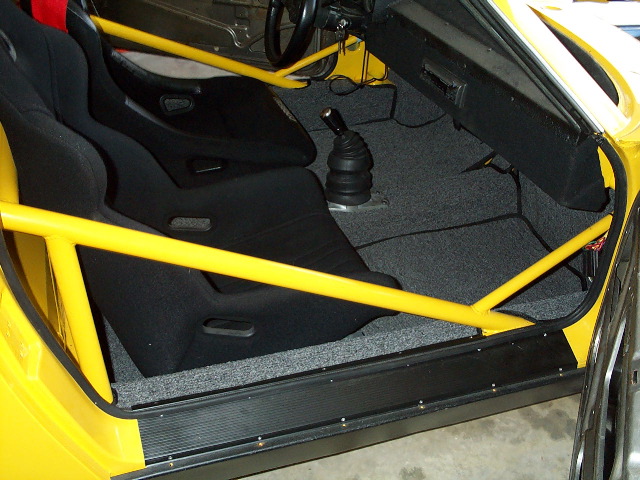
Posted by: Bigbohr Dec 14 2004, 09:23 PM
If that goes into the front trunk and the engine compartment, I wouldn't mind seeing pics of those areas.
Thanks
Posted by: Series9 Dec 14 2004, 10:07 PM
This is the best one I have right now (I'm on the road).
If you look carefully at the bottom of the picture, just behind the trunk spring mount, you can see the welded mount for the 1" tubing coming from under the dash. If you look across you can see the opposite tube going to its mount. If you look in the front, you'll see the two 1" tubes residing in that space.
All the tubing in this car is straight in order to keep rigidity to an absolute maximum.
I can take additional pictures when I get home later this week. I have good pictures of the engine bay and rear trunk.
Attached image(s)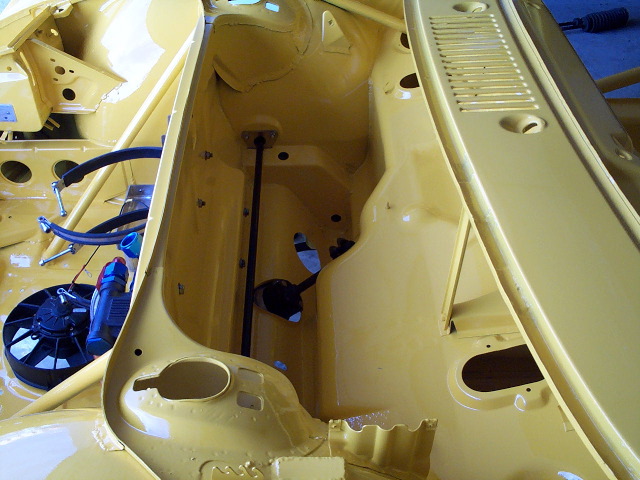
Posted by: Series9 Dec 14 2004, 10:10 PM
engine bay:
Attached image(s)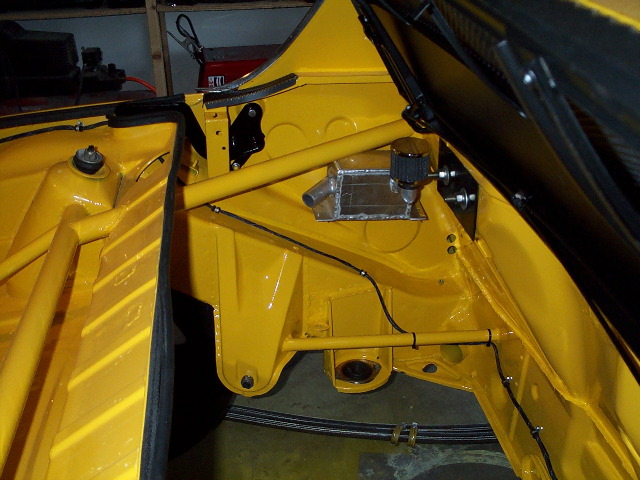
Posted by: Series9 Dec 14 2004, 10:11 PM
rear:
Attached image(s)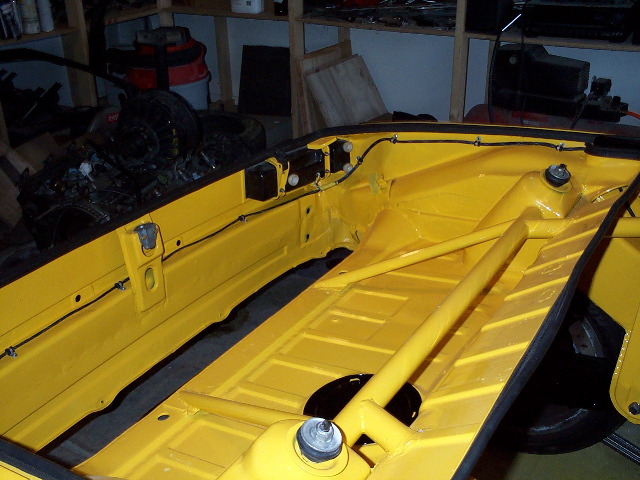
Posted by: JOHNMAN Dec 14 2004, 11:22 PM
No Eric. That will do. A picture is worth a thousand words as they say.
I tied the windhield frame into the cage at the top of the windshield frame probably 16 years ago.
The windshield frame moved enough on the track that it would actually rub on the cage and would otherwise create noises. During that season, I decided to tie the frame into the cage to prevent the squeaks/rattles. After doing that, I pretty much forgot about it.
The areas that we experience cracked paint is normally in the same area, but further forward. We also (in our infinate wisdom) welded the joint between the fender and cowl. This area would routinely crack the paint until we cut out the joint and replaced it with sheet metal. Our cowl and fender now form a 90 degree sharp corner and this seems to be a stress concentration as that corner is where our paint will crack now.
(I am convinced that this is the reason for the plastic welting in the joint to begin with). In other words, I believe Porsche knew the fenders/cowl/windshield frame moved too much to weld all that together and created the "expansion joint" to address the issue.
I have noticed that the cracks in our paint starting at that sharp corner (stress concentration) start only after a severe jar (dropping a wheel off the edge of the track into a HOLE or hitting VERY VERY bumpy alligator strips). These severe "jars" are HARD. Hard enough to bend a strut (which I have actually done on one occasion).
Posted by: SirAndy Dec 14 2004, 11:42 PM
you could always follow what they did on some of the GTs ...
here's the lufthansa GT ...
Attached image(s)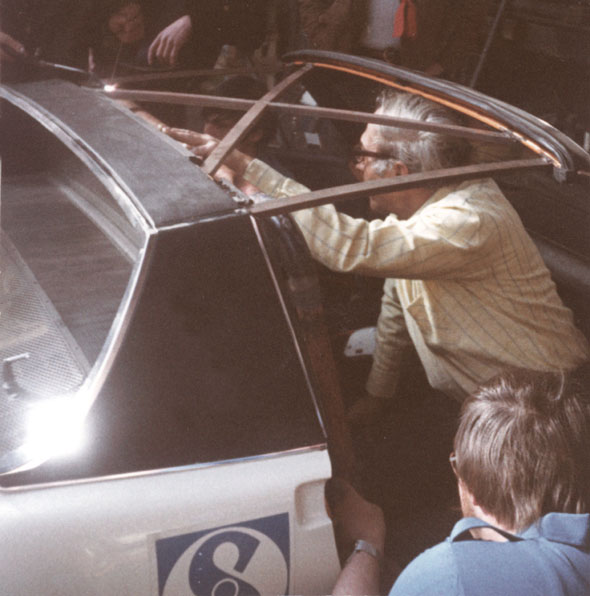
Posted by: Eric_Shea Dec 15 2004, 11:40 AM
Andy... awesome picture. ![]() Where the hell did you get that? (we know you didn't take it because, a. it's in focus, and b. you'd probably be about 1 year old when that was taken)
Where the hell did you get that? (we know you didn't take it because, a. it's in focus, and b. you'd probably be about 1 year old when that was taken) ![]()
With this thread I was wondering about how they made the bracing to fit so precisely. Looks like they welded it up first and then glassed it to the top. Perfect timing (for me anyway). Thanks for the pic. Any more?
John, You bring up another good point. There's a lot of people on the board that weld that cowl joint up. I "think" Brad's #0004 had them welded shut as well. From your real world experience it seems like those really "need" to be there. Not a good idea to weld them shut.
Posted by: sixnotfour Dec 15 2004, 11:51 AM
--------------------------------------------------------------------------------
Andy... awesome picture. Where the hell did you get that? (we know you didn't take it because, a. it's in focus, and b. you'd probably be about 1 year old when that was taken)
Posted by: Travis Neff Dec 15 2004, 02:15 PM
What about glassing in some square or rectangular stock to the targa top (or just a stiffening U/square channel and or X brace with glass and matt alone), one on each side by the window seal, fore to aft. to give some spine to the top. The front latch is pretty stout to pull the top to the windshield frame (compared to the rear). On the rear change out the hook and pin latch mechanism for a straight down pin type latch (like the rear trunk), then you could set the pressure to preload the rear seal, or even have the pins be adjustable fore aft within a channel to preload push or pull needed to keep things square. That would hold it a bit more steady than what is in there now and could be made to be fairly light. Obviously not a super strong approach, but could use what's there with a couple tweaks for a super duty street car.
my windshield frame will wiggle easily when I grab it and pull it back and forth, I too was wanting to reinforce the A pillar area to help. If I do this, what should I use for material, some flat bar stock bent and welded, some heavy gauge sheet stock with some beads?
What about where the cowl meets the windshield base, can this use some extra support, then tie to the upright supports as I talk about above (like using 1", 1/8 flat bar stock), from windshield support to windshield support, effectively making a "U". You could bend the bar stock to get close to the windsheild base and follow the contour, wrap around the corner to the upright supports. This could be done in the front trunk compartment, or under the dash in the cabin - so it would be hidden.
Posted by: Brett W Dec 15 2004, 02:46 PM
Guys you are missing the main problem. Not enough complete box sections in the chassis. If you can complete more boxes, increase the cross section of existing boxes, you will gain eponentially more stiffness than you would if started making all of these band-aids.
Look at the early aluminum Monocoques. They used very few tubes and many panels. You could take the factory tunnel out and put in one of a much larger cross section. You could increase the size of the factoy rocker boxes. Which are significantly stiffer than just about anything your are going to add or replace it with. Make a huge backbone through the car. This is probably the best thing you could do for the strength of your chassis.
You could build a very light weight frame of steel tubing for a seat that basically fills up the interior of the car. Make places to two seating areas and skin the whole thing in aluminum. Attach your frame to the basic 914 chassis and bond and rivet the aluminum sheeting to the frame and the chassis. This would increase your torsional stiffness incredibly. Yes it will be a massive amount of work. Would it be worth it. Absolutely.
Attached image(s)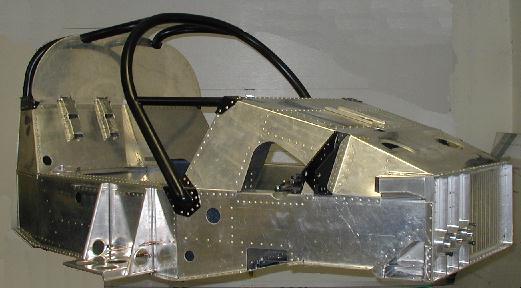
Posted by: Mueller Dec 15 2004, 02:48 PM
my windshield frame will wiggle easily when I grab it and pull it back and forth, I too was wanting to reinforce the A pillar area to help. If I do this, what should I use for material, some flat bar stock bent and welded, some heavy gauge sheet stock with some beads?
What about where the cowl meets the windshield base, can this use some extra support, then tie to the upright supports as I talk about above (like using 1", 1/8 flat bar stock), from windshield support to windshield support, effectively making a "U". You could bend the bar stock to get close to the windsheild base and follow the contour, wrap around the corner to the upright supports. This could be done in the front trunk compartment, or under the dash in the cabin - so it would be hidden.
from what I have read here, it now seems to be a bad idea unless you reinforce where the windshield frame meets the cowl area (A-pillar)....
the factory roll bar is stronger than the windshield frame, if (more like when )the car flexes, the forces are going to find the weakest link and that would be the windshield frame...with enough force, the windshield could crack....I'd like to know if the factory 916s had this problem, but I highly doubt many of them have 100k+ miles on the chassis and still being daily driven
Posted by: Travis Neff Dec 15 2004, 04:12 PM
Sorry I wasn't clear, I was meaning doing the windshield frame support and top reinforecement together, again does that sound reasonable.
Brett,
Where would you finish completing boxing of the 914 chassis, I want to visualize what or where to do this as you are stating
Posted by: Eric_Shea Dec 15 2004, 06:06 PM
Travis, with the exception of your pin on the rear section (they bolted theirs in) it sounds like your talking about a factory GT setup. They also glassed theirs to the roof.
Gints a-pillar mod was sheet stock (10 gauge?) and followed the GT pattern. Check the photos on Jon Lowes site for more on that. It will be completely hidden once the interior trim is added. He commonly grabs his frame to get in and out of the car.
I think everyone's on (to) something here... ![]()
Brett seems to be talking about an all out FP type car or more.
John's car has a welded in cage that probably negates some of these issues.
Gint's car is a -6 that will have a mild-hot motor, will see some track time and won't have a cage.
Mike - ? I don't know what your plans are for that car.
We've discussed the issues of bracing the a-pillars and the roof ala a GT but really haven't addressed the question. "How much stiffer with solid or tied in roof?"
I "think" solid would be noticably stiffer (I only have a 911 to reference and old stories about the 916). Tied in like a GT would probably be noticably stiffer as well. But, as Brett and/or others have mentioned, most of your rigidity will probably come from strengthening the longitudinals. Might as well keep the targa top as it is and get an Engman kit. If you did weld on a solid roof you can still have problems if you don't address the flex that John points out (which probably means full tube, seeing as how he has a full cage and still has the flex). I raced my 911 without a roll bar or a roll cage for quite a few years and when it came time for the RS conversion the a-pillars were cracked. It's a non-sunroof coupe.
If someone were to come up with a 916 roof blank I think I'd consider it ![]()
Posted by: airsix Dec 15 2004, 06:13 PM
Ohhh! A 962. Me likey.
(It is a 962, right?)
-Ben M.
Posted by: Travis Neff Dec 15 2004, 06:50 PM
Just got my engman kit last week, and a welder yesterday. Just trying to figure out what things I can ruin errr um strengthen heh.
Thanks for the metal size for the uprights, I will definately do that just for the fact it's so flexy on this car.
Posted by: JOHNMAN Dec 15 2004, 08:34 PM
Ok Eric,
Back to the topic....
In my opinion.... simply tying the roof into the existing windshield frame and the Roll Bar (without the benefit of a full cage) would only marginally stiffen the chassis.
just my $0.02
Posted by: Brett W Dec 15 2004, 08:43 PM
Eric you could use it on any type of car but it would do away with the regular up right seating and lay the driver back in a very Formula car"esque" seating position. Might be a problem for tall drivers. Look at the seating styles for some of the GTP cars, 962, McLarens, etc.
Travis
Starting at the front of the car, front trunk, big open box. (not really a big concern because it is just holding up the sheetmetal). Fuel Cell area, under windshield cowl. Open box with three panels. all connect to different pieces. None share a common joint. Both A-pillars just standing out in space. Partially bridged by the windshield cowl, sorta not really. The manufacture basically wanted the joint between the cowl and firewall to form the majority of the strength in that area. To bad it didn't work. So basically you have the strut towers connected to these beefy pieces of metal (the strut towers) with nothing on either side of any substance. So they pivot back and forth. The A-pillars flex in and out.
The tunnel is connected to one little piece of .050 sheetmetal with a couple of spot welds. That tunnel dead ends into a flat piece of material with nothing behind it but open space. The firewall wiill flex in bending and torsion. The framerails them selfs aren't all that bad. they are really stiff in bending and would be in torsion if they were connected together.
In the back the tunnel is connected another piece of .050 sheetmetal. This piece is backed with another peice of similar thickness but it is only connected in a couple of places. The firewall is folded over and spotwelded to the front engine shelf. That provides some stiffness but not a whole lot. Engmans kit helps here a little but all it does is add thickness to the one piece of sheetmetal. What it should do is build a box that comes off the firewall and is connected to the tunnel with another boxed piece. This would cause seating issues for most people.
The rear frame rails are braced by on pre-bent peice of .050 sheetmetal (the inner fender panel). So what happens when these are loaded in torsion, as the factory suspension points loads the rear suspension, The box tends to twist in and up. Basically trying to roll up towards the engine. Now a shaped panel that fits in the corners of the engine bay would do wonders for increasing the box section of that area. Adding the 2inch .043 wall tube underneath the engine lid mounts and 3in x.043 under the rear engine shelf would make noticable difference in a stock vehicle. As would bracing from the fire wall to the rear suspension mounts.
Remember most manufactures have packing issues and cost issues that come into play in deciding where stuff should be. So these issues might have gone away had the model been updated several times.
Posted by: Travis Neff Dec 16 2004, 11:31 AM
Thanks Brett, that illustrates a lot. Was starting to dawn on me what you were talking about, with the open box cavities of the trunks (and trunk sub sections), but was not sure if you meant "box" as in the imaginary box that runs side to side between axles and fore/aft beteen the front and rear axles.
For the lower tunnel (dunno what to call it) where the steering rack goes, I guess you could make a bolt in panel with some beef (16 guage) and use a brake to make 90degree bends on the perimiter and weld them up (so it would look like a shoe box lid upside down. to give it more spine you could do rectangular stock or strap running front to back or in an X that becomes the mounting boss for the attachment bolts.
With the Engman kit, you could run some flat stock triangles (like 2-3" triangles) to gusset the outer corners to the longs/floor, inner corners to the tunnel/floor, stitch weld the tunnel to the floor, as well as the seat mount U channels, gusset the front facing corners on the floor, and the rear facing corners at the top of the tunnel to seat channel/top of the seat channel to long. Could probably even do a gusset at the rear corners at the top edge of the kit as well without any problems with the rear upholstery panel. Stitch weld the tunnel to the floor, as well as the seat adjuster channel, gusset that at the top (rather than the floor, since no one will see it, or wont get in the way). Bracing/reinforcing the seat channel to the longs/tunnel is right close to the weak spot in the cockpit, could even do flat bar stock on the floor in the side to side stamps at that crtical point, welding that to the long to tunnel and stitch along the floor. It would seem that you would need and X there to really get some strength, but that could be intrusive or very evident looking at the carpet (unless you have backing pad on your carpet that you could cut out the X so it lays smooth.
Maybe run 18 guage steel across the front gastank firewall and wrap the wheelwells to finish the box structure of the Engman kit (as well as a kickout to mount along the floor surrounding the pedal mounts. this would be double duty, one tying the front sections of the "U" to make a box of that Kit, then also reinforce the MC mount, and kickout to reinforce the pedal box mount (mine is super flexy). run spaced out stitch welds along the top and bottom of the engman kit, and stictch the tunnel to the kit. for the sake of giggles a heavier guage plate could be welded to the fore/aft ending sections of the tunnel to the firewalls (whether it is done in the gastank or engine compartment side, or inside the cabin - I dunno). and of course stitch weld the structure panels (upper to lower firewall, trunk, etc.)
The lower brace for the Suspension console is a given, I am up in the air about the top of the firewall to the shock mounts, I am trying to think of a way that those fore/aft tubes can run out of sight and out of the way. Along the upper firewall with rectangular stock doesn't bother me too much, but I would think you would need to ditch the battery location for the fore/aft tubes, or run them more inward getting in the way of working on the engine.
I have to figure out what parts to fab for the suspension console, inner scab plates, straps (like Brants' setup) the outer portion of the suspension consoles and whatever else makes sense (and someone may recomend). what about welding some sheet metal at the bottom of the suspension console to complete the box there? Could go so far as cut out the cover plate of the rear frame rail, weld a panel over the long (like the factory kit), butt weld the cover plate back on and grind down the welds so it'd be stealthy.
I will do the windshield frame reinforcement, what about changing the style of a rectangular piece, to an L, going along the windshield frame/door frame, and then inward on the inside of the cowl a touch. From Eric's photos, what about a sheet metal plate on the underside of the cowl corners on the trunk side? Just another thought.
I am going to drill out the spot welds on the front facing rear trunk panel, weld/reinforce the long to the shock mount (maybe an L piece on each side), could even (if there is room) to run a tube from long to long (maybe overkill to tie the shock towers together, but I would guess the longs could use the help. then weld the panel back over, so you wouldn't see it.
I have to weld in a front trunk floor to patch the A/C cutout, the trunk floor is very flimsy with this huge chunk gone. What about a bar to tie the front torsion bar mounts?
Like I said, just got my welder and I am finding all sorts of stuff to do, that of course will be very much overkill for what I need. But hell, it's gonna be a fun project. and I wanna throw out some ideas and have someone say, good, or your stoopid. And hopefully not have the car weight 3k when I get done, weld too much and mess up the chassis regardless of bracing while welding or whatever. Just trying to get some good ideas to ponder or try.
I am sure someone is going to ask, what are you planning on doing to your car, race, street etc. Probably HD street and some autocross, don't care about class placement right now since I will start from the ground up. All I know is I am gonna start welding, fixing the bad stuff, reinforce the problem spots, and maybe try something new along the way. mostly street I guess, it has ugpraded 150lb springs (at the moment), 22mm t-bars and koni sport shocks w/adjustable perches. No swaybar, yet - but that is coming.
Posted by: SirAndy Dec 16 2004, 12:06 PM
no more pics from that particular car. no link ...
but i have my secret sources for pictures, i hope to get ahold of much more stuff soon ...
here's another interesting GT pic, don't know if that has already been posted ...
"Marathon de la Route, 1970"
Car #: 61
Drivers: Walter Simonis (D), Horst Hoier (D), Ulf Kayser (D)
Rank: DNF
Engine cc: 1991
Engine Type: B6
Group: GT
Attached image(s)
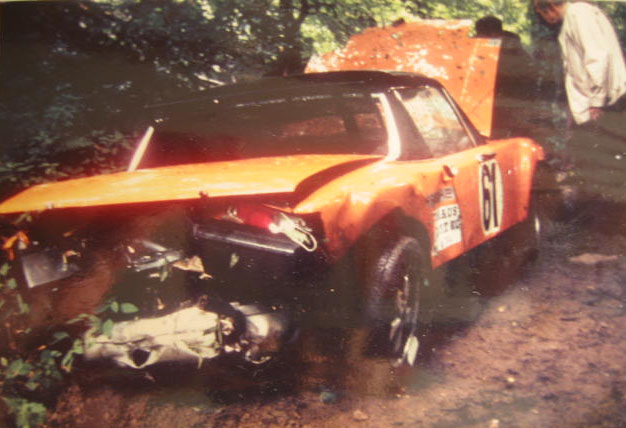
Posted by: turbo914v8 Dec 16 2004, 01:18 PM
Ok, so far I have heard a lot of great ideas regarding how to fix the flex in the 914. On one hand you could weld a bunch of steel plates here and there, seam weld, etc. On the other hand you could put a cage in and tie the 4 suspension points together etc. So much information, I am confused. Would not a cage solve most of the flex problems, combined with some plates welded in strategic places? Some one please clarify?????? ![]()
Regards,
Turbo Paul.
Posted by: Brett W Dec 16 2004, 02:33 PM
The reason many people shy away from the cage is streetablility. Momma doesn't want to have to crawl over the cage in the dash from the grocery store in the rain. Now if you are single, chicks dig roll cages. For the most part the cages that I have seen on street cars only meet the letter of the rules, just adding wieght with very little extra chassis stiffening. If the cages were tied to the chassis in several places that would help.
Travis, those are all great ideas, but I think you are going to end up with more weight than stiffness with a lot of those mods. If you are going from the ground up you can fix a lot of these problems by removing and relocating panels. Look at other peoples stuff first.
http://e30m3performance.com/tech_articles/cage_symposium/cage_symposium.htm
http://sports.racer.net/images/chassis/cheetah/chassis/build/tub_clecoed.jpg
http://sports.racer.net/images/chassis/cheetah/chassis/chassis_side.jpg
http://sports.racer.net/images/chassis/cheetah/chassis/chassis_aboveside.jpg
http://www.erareplicas.com/427/deslogic.htm
Look at books about airframe structure design, etc and learn about what materials have what properties. I.E. did you know that a 4"x 6" x .050 wall rectangle tube is substantially stronger in bending than a 1.5" x 3" x .250 wall tube. This is something many people miss. Always look at the tubing characterstics vs. weight. 1.75 x .065 is stiffer than a peice of 1.5 x .095 and they weigh about the same. 1.5 x .095 wieghs 1.426lbs/ft where as 1.75x .065 weighs 1.170lbs/ft
Just start doing some searching on the net and start calling the guys that do this for a living and see what they will share. Start bothering people until they share their secrets or they run you off.
Posted by: Travis Neff Dec 16 2004, 02:50 PM
The right cage would fix most of them. Bring money, if you are going to build a cage for yourself great, if you are going to compete and want to rely on your work to save your life, that could be a tossup (and maybe not!). Getting the right sized material, the right material and figuring out the best execution can be tough. Also welding pipes together is difficult to weld with the right penetration, heat stress etc. My Dad built a sailboat and did tons and tons of aluminum welding with a MIG (and a gun with built in wire roll). Welds all look great, he got lots of practice. However his life line supports around the boat (which was tube welded to a circular base plate, every 3 or so feet) started breaking. Few broke at the weld (poor weld) and the majority of the failures were the tubes cracked above the weld where the metal got too stressed from heat. Welds looked good to me (an untrained eye), and sometimes you may not know unless you start cutting apart enough of your work to prove yourself right or wrong.
the brace from the trailing arm to the engine firewall would be separate from the cage.
You could tie in all the suspension points, then weld plates to chassis in spots, like a windshield frame tie in, rear firewall tie in, NASCAR style door braces etc. However going the super indulgent way may put you out in a fire breather class for racing. For street, it can be a bear to get in and out of and if you are not wearing a helmet those bars can do some damage on your noggin' even if it was padded up real well
So, with the right cage - problem solved, albeit a compromise on for street driving.
Or you can do a smaller scale cage - plus reinforce in strategic areas, maybe this is the best of both worlds.
Or you can stitch weld the unibody up in the trouble spots, add stiffening kits (or make your own style) and have it unobtrusive for street driving. Some works great, some long time kits don't do much, doesn't change the appearance and features (xept for flexing so much) of the car. What I am after (and everyone who has commented is probably driving in a different direction) is the tricks for a hot street setup.
This board is great, there are some very knowledgeable people and a lot of people who aren't afraid to do some digging and share their findings. There is a ton of new things as of late regarding the chassis, and this is on 30 year old cars. maybe some people knew waaay back when but the kept a lot of stuff quiet. Not here, I love it! Someone has a generalized question (roof being tied in like the GT cars, pros-cons?) we got a ton of answers, some reinforcement is good, some reinforcement is bad, options for changing the chassis around all together and a couple new ideas to ponder.
I am sure some time along there will be a pretty good guide for modifying your car, what's good, what's bad and why. Cars are getting older and weaker, suspension technology (or lets just say brute force on the chassis) is very different when the factory raced these cars when new, wide rims and sticky tires added to the mix and you can pull your car apart a lot easier than with a near stock setup.
So far, we have unboxed areas of the car, stress points and failures of general use, what the factory racers did and some speculation of what other things they had to do to counter what they originally did. The rear Longs arent welded to the rear shock towers, the whole rear of the car wiggles a bunch from the stress of the layout, the suspenion console can rust, or just rip out completely if pushed hard, the center of the car (or directly below the top of the windshield frame is the cars weak point (and a kit to help alleviate it, the factory GT kit only has a few parts that really work well and some parts were never put in the right spot, like reinforcing a cover over the frame, rather than the frame itself
Posted by: Travis Neff Dec 16 2004, 02:57 PM
Thanks Brett, I wil check the links out. I agree that everything I have said is a lot of metal. And no, I don't know what tube types are stronger than others, don't know at which point a certain metal is strong without becoming brittle, not knowing at which point reinforcing (or I shoud say welding/heat) will have a diminished return. I am asking questions just like you said, and I aim to ask a bunch more before I get started. You wont learn much if you have someone else do it, or not participate in sounding things out.
![]()
Posted by: Brett W Dec 16 2004, 04:40 PM
Amen brutha'
I been buggin' the hell out of a bunch of people. I have yet to be told to go away.
Posted by: Jeroen Dec 16 2004, 08:53 PM
This turned into another great thread!
I'm totally into chassis design and hopefully at some point in my life I will build something nice from scratch
Earlier this year I visited the Donkervoort factory here in the Netherlands (they build very high spec Super 7 type cars) and that was a real eye opener.
They build their chassis form 2x2 cm square tubing with a wall thickness of only 1mm ( 0.8x0.8" .04" wall)
A completed chassis is very strong and rigid and only weighs about 90#
Powered by Invision Power Board (http://www.invisionboard.com)
© Invision Power Services (http://www.invisionpower.com)